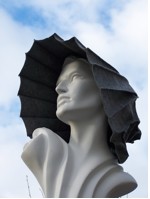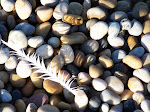Attended a conference at Leeds City Museum based on the 'Inlaid Patchwork in Europe from the 1500 to the Present' on show at Leeds Art Gallery at the moment. It was led by one of the German curators and conservator Salwa Joram, who was a passionate speaker and full of so much enthusiasm for the topic it was infectious. Inlaid patchwork is made of wool cloth (plain weave wool which is then felted, which is reminiscent of the felt hoods we use in millinery), usually from the offcuts from tailoring, as there was no fraying there was little wastage. The earliest example in the exhibition is a 17th century horse blanket created for the christening of a Saxony prince, really beautifully made and shows counter change. Lots of the pieces that survive were alter cloths from Silensia a renowned wool production area in Germany, also Scandinavia and Switzerland. The Berlin Museum has been sourcing the pieces around the word since the 1980's.
 |
| Traditional Altar Cloth |
 |
| 2009 | | | |
The journey of this form of patchwork then moved to England where they were made by tailors and the hours to make them would be recorded, one stated it was 18 years in the making, they would then be toured around a region for an entry fee. The quality of manufacture was much higher and used to promote the skill of the tailor. Leeds City Museum has an exceptional example of this as does Biggar Museum outside Glasgow. All very fascinating and enlightening.
I particularly loved the modern version made by a German textile artist Ursell Arndt based on the Berlin Wall and Graffiti around the city, some nice Banksy as well. The work was so intense that she had to create a co-operative to help her, it took 20 women 4 months, it is exquisitely made and difficult to comprehend pulling it all together as the pieces are so random.
 |
| Detail of Graffiti piece |
 |
| Indulgence |













My mum went to this, she said it was very interesting too - wish I could have made it.
ReplyDelete